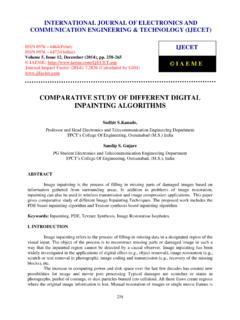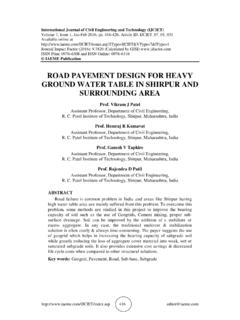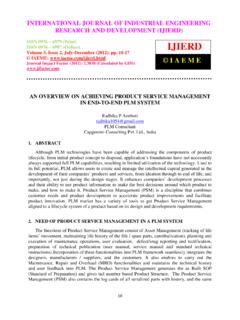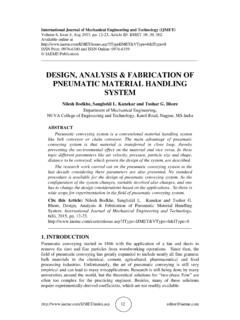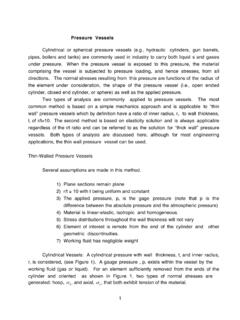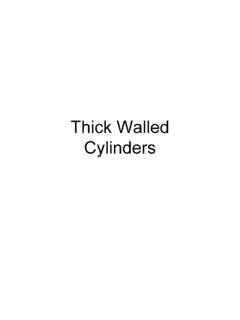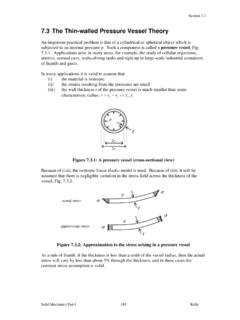Transcription of 2 ANALYSIS OF A THIN AND THICK WALLED PRESSURE …
1 INTERNATIONAL. International JOURNAL. Journal of Mechanical EngineeringOFandMECHANICAL ENGINEERING. Technology (IJMET), ISSN 0976 6340(Print), ISSN 0976 6359(Online), Volume 5, Issue 10, October (2014), pp. 09-19 IAEME. AND TECHNOLOGY (IJMET). ISSN 0976 6340 (Print). ISSN 0976 6359 (Online). IJMET. Volume 5, Issue 10, October (2014), pp. 09-19. IAEME: Journal Impact Factor (2014): (Calculated by GISI) IAEME. ANALYSIS OF A thin AND THICK WALLED PRESSURE . vessel FOR DIFFERENT MATERIALS. 1 2 3. Qayssar Saeed Masikh, Dr. Mohammad Tariq, Er. Prabhat Kumar Sinha 1. Local Administration, Karbala Governorate, Republic of Iraq 2, 3. Assistant Prof., Department of Mechanical Engineering, SSET, SHIATS-DU, Allahabad, India ABSTRACT. In the present work the problem of calculation of the stress developed in the thin and THICK cylindrical PRESSURE vessels is numerically solved by using software in C++. The ANALYSIS has been done for two different materials PRESSURE vessels.
2 The variations in the thickness of the PRESSURE vessels have been considered for the ANALYSIS for different internal pressures. The common characteristic of the PRESSURE vessels solved is that the radial and tangential stresses vary in the same nature of curve for different thickness of vessels. Lame's equations, maximum normal stress theory, maximum shear stress theory have been applied for the ANALYSIS of the THICK WALLED PRESSURE vessels of brittle and ductile materials. ANALYSIS also performed for open and closed end cylinders by using Burnie's equation and shear strain theory. Barlow's equation has been applied for the calculation and ANALYSIS of the high PRESSURE oil and gas pipe ANALYSIS . The yield point stress and ultimate stresses have been considered for the ductile and brittle material respectively. The modeling details of the methodology, employed in the ANALYSIS , are extensively discussed and the numerical approach is proven to be very efficient for the software developed of PRESSURE vessel for thin and THICK cylinders.
3 Keywords: THICK WALLED Cylinder, PRESSURE Vessels, thin WALLED Cylinder, Ductile Material, Brittle Material. 1. INTRODUCTION. The design of PRESSURE vessels for operation at very high pressures is a complex problem involving many considerations including definition of the operating and permissible stress levels, criteria of failure, material behavior, etc. For the purpose of developing the design philosophy and the relative operational limitations of various approaches, the elastic strength or yielding PRESSURE of the vessel will be used as the criterion of failure. It should be noted, however, that some designs can be used at pressures in excess of that at which yielding of one or more components is predicted. 9. International Journal of Mechanical Engineering and Technology (IJMET), ISSN 0976 6340(Print), ISSN 0976 6359(Online), Volume 5, Issue 10, October (2014), pp. 09-19 IAEME. Generally, however, the use of vessels beyond the yielding PRESSURE will depend upon the amount of plastic strain permissible and the ductility of the materials involved.
4 At first glance there is little in common between an aircraft fuselage, a gas cylinder and a beer can, they are in fact all PRESSURE vessels which must be designed to meet very specific requirements of integrity and cost, although the exact match of these vary widely. Also, the impacting issues of life expectancy, environmental effects, effect of cyclic loading, inspection during manufacture and use, together with product liability considerations all have to be taken into account. Fuel tanks, rocket motor cases, pipes are some examples of PRESSURE vessels made of composite materials. Ever increasing use of this new class of materials in conventional applications is coupled with problems that are intrinsic to the material itself. Difficulties are many folded. Determination of material properties, mechanical ANALYSIS and design, failure of the structure are some examples which all require a non-conventional approach.
5 Numerous applications concurrently are accompanied by various researches in the related field. Majority of the studies in the ANALYSIS of PRESSURE vessels finds their origins in Lethnitskii's approach [1]. H. Al-Gahtani et al., [2] have numerically investigated the feasibility of a proposed local PRESSURE testing to verify structural integrity of nozzle-to-shell junctions in repaired/altered spherical PRESSURE vessels. The application of the theory given in this book is later applied to laminated composite structures in tubular form Tsai [3].The studies followed consider also different loading and environmental conditions. Recently, there are some studies involved directly with tubes under internal PRESSURE [4, 5]. In the study by Xia et al.[5], the combined effect of thermo mechanical loading in addition to internal PRESSURE is considered. Cassandra A. Latimer, M. S. et al., [6] have examined the impact of vascular proteins on bipolar seal performance found that collagen and elastin (CE) content within porcine arteries was a significant predictor of a vessel 's burst PRESSURE (VBPr).
6 Abhay K. Jha et al., [7], carried out the detailed metallurgical investigation to understand the cause of failure. High strength low alloy (HSLA) steel with a nominal composition of 1Mo . is being extensively used in space programme. The procedure is based on the classical laminated plate theory. A cylindrical shell having a number of sub-layers, each of which is cylindrically orthotropic, is treated as in the state of plane strain. Internal pressures, axial force, body force due to rotation in addition to temperature and moisture variation throughout the body are considered as loading. In the study of Kat rc [8], these parameters are compared with the experimental results. M. Walker and Tabakov [9], have provided an original in-depth ANALYSIS of the problem and then a new technique for determining the optimal design of engineering structures, with manufacturing tolerances accounted for, is proposed and demonstrated.
7 The numerical examples used to demonstrate the technique involve the design optimization of anisotropic fibre-reinforced laminated PRESSURE vessels. Jacek Kru elecki and Rafa . Proszowski [10], have investigated the problem of shape and thickness optimization of thin - WALLED PRESSURE vessel heads. The optimal geometry of a closure, which minimizes the design objective containing both depth and capacity or both depth and volume of the material of a closure (two variants) is looked for in the class of the uniform strength structures. Three types of optimization problems are considered: the optimal shape is sought for a prescribe wall thickness; the optimal wall thickness is sought for a prescribed shape of a closure and the case when we look for both shape functions. 2. MATERIALS AND METHODS. PRESSURE vessel Design Model for Cylinders THICK Wall Theory THICK -wall theory is developed from the Theory of Elasticity which yields the state of stress as a continuous function of radius over the PRESSURE vessel wall.
8 The state of stress is defined relative 10. International Journal of Mechanical Engineering and Technology (IJMET), ISSN 0976 6340(Print), ISSN 0976 6359(Online), Volume 5, Issue 10, October (2014), pp. 09-19 IAEME. to a convenient cylindrical coordinate system: , , . These are tangential, radial and longitudinal stresses respectively. Stresses in a cylindrical PRESSURE vessel depend upon the ratio of the inner radius to the outer radius (ro / ri) rather than the size of the cylinder. Principal Stresses ( , , ). 1. Determined without computation of Mohr's Circle;. 2. Equivalent to cylindrical stresses ( , , ). Applicable for any wall thickness-to-radius ratio Cylinder under PRESSURE Consider a cylinder, with capped ends, subjected to an internal PRESSURE , p , and an external PRESSURE , p , Figure 1: Cross sectional view of Cylinder with cap ends The cylinder geometry is defined by the inside radius, ri, the outside radius, ro, and the cylinder length, l.
9 In general, the stresses in the cylindrical PRESSURE vessel ( , , ) can be computed at any radial coordinate value, r, within the wall thickness bounded by ri and ro, and will be characterized by the ratio of radii, = ro / ri. These cylindrical stresses represent the principal stresses and can be computed directly using equations 1 and 3. Thus we do not need to use Mohr's circle to assess the principal stresses. Tangential Stress: .. = for r r r (1).. Radial Stress: .. = for r r r (2).. 11. International Journal of Mechanical Engineering and Technology (IJMET), ISSN 0976 6340(Print), ISSN 0976 6359(Online), Volume 5, Issue 10, October (2014), pp. 09-19 IAEME. Longitudinal Stress: Applicable to cases where the cylinder carries the longitudinal load, such as capped ends. Only valid far away from end caps where bending, nonlinearities and stress concentrations are not significant.. = for r r r (3).. Two Mechanical Design Cases 1.
10 Internal PRESSURE Only (p = 0). 2. External PRESSURE Only (p = 0). Design Case 1: Internal PRESSURE Only Only one case to consider the critical section which exists at ro/ri Substituting po = 0 in to eqs. (1 and 2) and incorporating = ro / ri , the largest value of each stress component is found at the inner surface: . r = r ) = , = p = p = p C .. Where . C = = is a function of cylinder geometry only . r = r ) = , = p . Natural Boundary Condition Longitudinal stress depends upon end conditions = p C for capped ends = 0 for uncapped ends . Where C = The thin - WALLED PRESSURE vessel Theory An important practical problem is that of a cylindrical or spherical object which is subjected to an internal PRESSURE p. Such a component is called a PRESSURE vessel , fig. 2. Applications arise in many areas, for example, the study of cellular organisms, arteries, aerosol cans, scuba-diving tanks and right up to large-scale industrial containers of liquids and gases.


